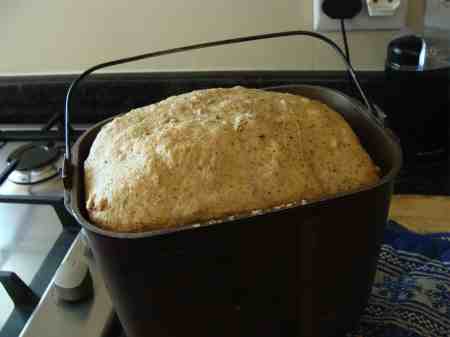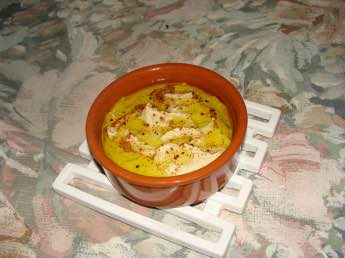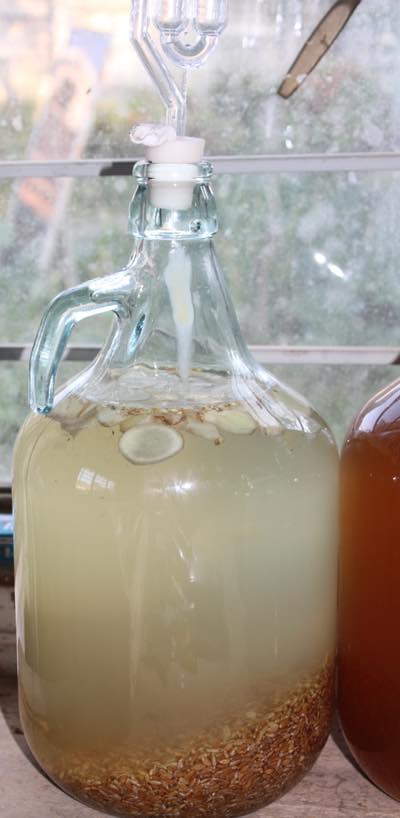- Bernard Preston homepage
- Our green kitchen
- Beer Bread Recipe
Beer bread recipe
You could follow this beer bread recipe with all-purpose flour but I only bake with 100% wholemeal; if you are going to go to the effort to make your own loaf then my philosophy is to use only the best ingredients.
Use the most unrefined flour you can buy if you want a truly nutritious and tasty-loaf.

There's a big fat-lie in the milling world; they are allowed to remove up to 40% of the goodies and still call it wholemeal. It is in effect a refined carbohydrate; that is why commercial bread is so fattening.
There is masses of strong scientific research confirming that whole-grains are particularly beneficial; but once refined they have in reality become a junk food that raises our blood glucose and make us obese. There is nothing good about commercial bread except the price; and that's because the best parts have been extracted and sold elsewhere at great profit.
Or as Jamie Oliver likes to say if it is junk then it can't also be food.
There is no such thing as junk-food. I like that and can see his reasoning. So we advocate using only 100% wholemeal, if you can get it; more about it below.
Ingredients
- 3 cups of 100% wholemeal-flour
- 1 TBSP hummus
- 1 tsp salt dissolved in a cup of water
- 1/4 cup of beer
- Squeeze of lemon-juice
- 2 tsp honey
- 1.5 tsp dried-yeast
- 3 tsp butter or coconut-oil
- Fit the paddle to the baking-tin.
- Add hummus, honey and butter.
- Add the salted-water and beer.
- Squeeze of lemon-juice.
- Grind and add the flour.
- Tweak the paddle to mix the ingredients.
- Sprinkle 1TBSP of flour over the surface.
- Sprinkle the dried-yeast over this flour on the dough.
- Put on 5 hour cycle in the bread-machine.
If you love bread and equally enjoy a good pint of beer then this recipe is for you. Keep to about 5/4 cups of liquid; play with the ratio of lager to water until it's just right for you.
I used to bake in the regular oven but gave it up many years ago; everything is so much simpler in a bread-machine. And it uses a lot less electricity, reducing your carbon footprint ever so slightly.
Bakers like to add a little protein powder to the dough; it improves the shelf-life and the crumb. Personally I find soya flour very indigestible so I prefer to use hummus. You could grind chickpeas if you have a mill.
Go for it
However if you have plenty of time on your hands and enjoy getting them sticky then this is how I used to do it.
- Mix together your flour, salt and only 1 tsp of dried-yeast in a large bowl.
- Add the beer, water and lemon-juice.
- Using your fingers lightly knead the flour into the liquid until you have a rough-shaped lump. Cover it with a clean, used plastic bag that you've cut open.
- Let it sit on the counter overnight; 12 hours is best.
- Lightly flour a marble or stone countertop and knead your dough into a ball, pulling the edges towards the centre in the usual way.
- Thoroughly grease the bottom of a Dutch-oven with butter.
- Or better still I save the butter wrappers in the fridge for this purpose; lay them on the bottom of the oven-dish.
- Invert your lump of dough into the Dutch oven and cover it with the plastic wrapper you used in step 3.
- Let it rise for about two-hours until it has doubled in size; at room temperature.
- Remove the plastic from your risen dough; cut a slit along the top about 1cm deep.
- Put the lid on the dish and place it in the hot oven at 220oC.
- Bake for half an hour with the lid on; remove the top for another 30 minutes.
- Remove the pot from the oven; once it has cooled a little, invert it carefully onto a wire-rack.
We love hot bread but serious bakers believe that the full-flavour can only be really appreciated after the loaf has cooled for an hour or two.
Allowing it to cool and even enjoying it the next day will certainly reduce the glycemic index of your beer bread recipe; the starches retrograde so they are absorbed more slowly in the intestine resulting in a much smaller blood-glucose spike.
That means it's less fattening too and more of the carbohydrate will reach the colon where it is fermented by the bacteria and yeasts forming important short-chain fatty acids instead of sugars.
If you are interested, grasping the meaning of starch is enormously helpful particularly for those who are struggling with their weight.
This long-winded process is a lot less certain with many mishaps. Give me an electric bread oven any day. Having said that, kneading the dough is wonderful exercise for the neck and shoulders and a part of that slower, contemplative way of life that we have lost; so don't let me discourage you if it is your passion.
Synergy

There is a synergy about preparing your own food. In an attempt to reduce our reliance on animal-protein we have slowly increased the amount of legumes we eat, much of it through this authentic hummus recipe.
Hummus doesn't keep which is why food manufacturers have to add so many preservatives that make it taste awful. So around the fourth day when it is beginning to ferment I use it as the vegetable protein that bakers like to add to their dough; it improves the shelf-life and the crumb.
In effect you are turning your bread recipe into a sourdough; this is even more true if you can find a small brewery. It won't work this way once the beer is pasteurised.
I brew this honey brown beer for my bread recipe; again, it's that synergy about green living.
Using honey it is often called a braggart.

Real bread
There are two strong movements throughout the Western World. Either giving up bread altogether, encouraged by the various keto ways of eating or turning to baking your own loaf with 100% wholemeal; and none of the added chemicals that are used by commercial companies. They are the source of the collywobbles that so many of us erroneously attribute to gluten.
You can read about it if interested at real and fake bread.
Grasping the meaning of gluten is also enormously important if you have bloating and discomfort after eating the commercial-loaf; those who give up their daily bread inevitably turn to highly refined starches to their great detriment.
Just read the labels on your gluten-free food and you'll see what I mean.
This completely unrefined loaf, free of chemicals is being called real bread. As the best beer is slow-brewed so dough that is proved the long winded way is so much tastier and more nutritious.
For this reason I often just include a little unpasteurised beer in our regular sourdough bread when looking for something different; then I allow it to ferment overnight.
The fermentation that occurs in the sourdough process is what reduces the influence of the anti-nutrients mentioned above. Those who enjoy a beer bread recipe made in this way need have no fear of lectins and phytates despite what the scaremongers have to say.
Beer bread recipe
This beer bread recipe is very easy to make using a dedicated electric oven but very long-winded by the traditional method.
When browsing use right click and "Open Link in New Tab" or you may get a bad gateway signal.
Newsletter
Our newsletter is entitled "create a cyan zone" at your home, preserving both yourself and Mother Earth for future generations; and the family too, of course. We promise not to spam you with daily emails promoting various products. You may get an occasional nudge to buy one of my books.
Here are the back issues.
- Lifestyle and ideal body weight
- What are ultra-processed foods?
- Investing in long-term health
- Diseases from plastic exposure
- Intensive lifestyle management for obesity has limited value
- A world largely devoid of Parkinson's Disease
- The impact of friendly bacteria in the tum on the prevention of cancer
- There's a hole in the bucket
- Everyone is talking about weight loss drugs
- Pull the sweet tooth
- If you suffer from heartburn plant a susu
- Refined maize meal and stunting
- Should agriculture and industry get priority for water and electricity?
- Nature is calling
- Mill your own flour
- Bake your own sourdough bread
- Microplastics from our water
- Alternative types of water storage
- Wear your clothes out
- Comfort foods
- Create a bee-friendly environment
- Go to bed slightly hungry
- Keep bees
- Blue zone folk are religious
- Reduce plastic waste
- Family is important
- What can go in compost?
- Grow broad beans for longevity
- Harvest and store sunshine
- Blue zone exercise
- Harvest and store your rainwater
- Create a cyan zone at your home
Did you find this page interesting? How about forwarding it to a friendly book or food junkie? Better still, a social media tick would help.
- Bernard Preston homepage
- Our green kitchen
- Beer Bread Recipe
Address:
56 Groenekloof Rd,
Hilton, KZN
South Africa
Website:
https://www.bernard-preston.com